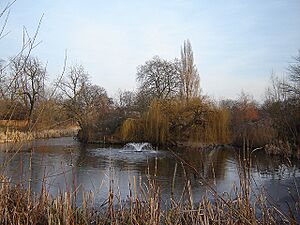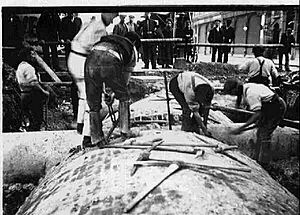Hackney Brook facts for kids
The Hackney Brook was once a small river in London. It flowed across the northern parts of Hackney and Islington. This brook started in Holloway. It then emptied into the River Lea near Old Ford. Today, you can't see most of it. It flows underground.
Where the River Flowed

The Hackney Brook started its journey in Holloway. From there, it flowed into Hackney. It went through the northern part of Clissold Park. Today, two lakes in the park show its old path. These lakes now get their water from the main city supply. They are not fed by the brook anymore.
The brook then wound its way through Abney Park Cemetery. It crossed the bottom of Stamford Hill road. After that, it ran along the north side of Stoke Newington Common. In the 1860s, builders found something amazing here. They found very old flint axes. These axes were about 200,000 years old! People were making them on the brook's banks. These are some of the oldest human tools found in Britain.
From Stoke Newington, the brook followed the west side of Hackney Downs. It then flowed south-east. It crossed Dalston Lane and Mare Street in Hackney Central. Many old pictures from the 1700s and 1800s show a ford here. A ford is a shallow place where you can cross a river. This ford was where the North London Railway bridge now crosses Mare Street.
In central Hackney, another small stream joined the brook. This was the Pigwell Brook. It flowed down from Dalston. From Hackney Central, the Hackney Brook continued through Homerton. It reached Hackney Wick. Here, it turned south. It ran next to the River Lea. Finally, it reached Old Ford. Old maps show it joined the Lea right there.
In its best days, before the late 1830s, the Hackney Brook was quite big. It could be 10 metres wide at Stoke Newington during floods. At its meeting point with the Lea, it might have been 30 metres wide. You can see its old path on some old maps here.
Why the River Disappeared
By 1856, much of the Hackney Brook was already covered. But the local population was growing fast. The parts of the brook that were still open became very dirty. They were like open sewers. To fix this, the Metropolitan Board of Works built a new sewer system. This was in 1860. It was designed by Sir Joseph Bazalgette. This new sewer was made to carry the brook's water and its smaller streams. The sewer followed the brook's path to Hackney Church Street (now Mare Street). Then it went south through Victoria Park. It joined the bigger sewer network at Old Ford.
Ideas for Bringing it Back
In 2016, a local person named Trevor ApSimon had an idea. He suggested uncovering the river. This is called "deculverting." He wanted to bring the river back from its source in Holloway to the Lee Navigation. He thought it would be cool to create a walking path. He imagined people strolling from "Hackney-on-High to Hackney-on-Sea" on a Sunday.
The Hackney Green Party mayoral candidate, Samir Jeraj, liked the idea. However, Tom Bolton, who wrote a book about London's lost rivers, said it was not possible.


